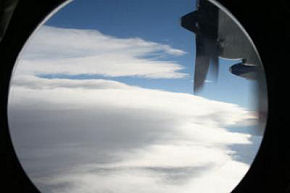18 May 2009
Cloud-seeding microorganisms go under the microscope
by Kate Melville
 A new study is the first to yield direct data on how bacteria, fungal spores and plant material influence cloud formation at high altitudes. The researchers, led by Kimberly Prather and Kerri Pratt of the University of California at San Diego, sampled water droplet and ice crystal residues at high speeds while flying through clouds in the skies over Wyoming. "If we understand the sources of the particles that nucleate clouds, and their relative abundance, we can determine their impact on climate," said Pratt.
A new study is the first to yield direct data on how bacteria, fungal spores and plant material influence cloud formation at high altitudes. The researchers, led by Kimberly Prather and Kerri Pratt of the University of California at San Diego, sampled water droplet and ice crystal residues at high speeds while flying through clouds in the skies over Wyoming. "If we understand the sources of the particles that nucleate clouds, and their relative abundance, we can determine their impact on climate," said Pratt.
Analysis of the ice crystals revealed that the particles that started their growth were made up almost entirely of either dust or biological material such as bacteria, fungal spores and plant material. While it has long been known that microorganisms become airborne and travel great distances, this study is the first to yield direct data on how they work to influence cloud formation. Results from the experiment appear in the journal Nature Geoscience.
The effects of tiny airborne particles called aerosols on cloud formation have been some of the most difficult aspects of weather and climate for scientists to understand. In climate change science, which derives many of its projections from computer simulations of climate phenomena, the interactions between aerosols and clouds represent what scientists consider the greatest uncertainty in modeling predictions for the future.
Aerosols, ranging from dust, soot, and sea salt to organic materials, some of which travel thousands of miles, form the skeletons of clouds. Around these nuclei, water and ice in the atmosphere condense and grow, leading to precipitation. Scientists are trying to understand how the nuclei form, as clouds play a critical role by both cooling the atmosphere and affecting regional precipitation processes.
The researchers performed in-situ measurements of cloud ice crystal residues and found that half were mineral dust and about a third were made up of inorganic ions mixed with nitrogen, phosphorus and carbon - the signature elements of biological matter. The second-by-second speed of the analysis allowed the researchers to make distinctions between water droplets and ice particles. Ice nuclei are rarer than droplet nuclei.
The team demonstrated that both dust and biological material indeed form the nuclei of these ice particles, something that previously could only be simulated in laboratory experiments. "This has really been kind of a holy grail measurement for us," said Prather. "Understanding which particles form ice nuclei, and which have extremely low concentrations and are inherently difficult to measure, means you can begin to understand processes that result in precipitation. Any new piece of information you can get is critical."
The findings suggest that the biological particles that get swept up in dust storms help to induce the formation of cloud ice, and that their region of origin makes a difference. The researchers note that evidence is increasingly suggesting that dust transported from Asia could be influencing precipitation in North America.
Related:
Plankton Generating Oceanic Cloud Cover
Fluffy Clouds Touted As New Menace To Life On Earth
Airborne Nanobacteria Spread Disease, Create Rain
Aerosol Pollution May Defeat Greenhouse Effect
Climatologists get to grips with aerosols
Source: National Science Foundation
